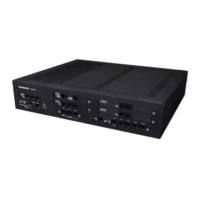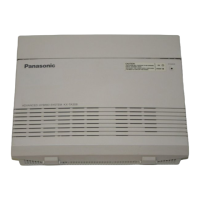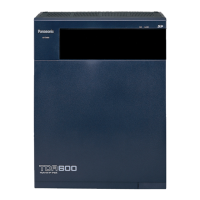Conditions
• KX-NSE101, KX-NSE105, KX-NSE110
, or KX-NSE120 (Activation Key for Mobile Extension) is required
to use this feature. One activation key is required for each extension (virtual PS) that will use this feature.
Also, the Mobile Extension setting for each virtual PS must be set to Enable.
• If no signal is received from a PS for the preprogrammed length of time when an incoming call is received,
the communication status of the PS is set to Out of Range, if enabled through system programming.
• When a PS comes within range of a certain PBX, Out of Range status is automatically released. However,
in some negative wireless network conditions, Out of Range status may not be released automatically. In
this case, the PS user can manually release Out of Range status by pressing the Talk key and confirming
that a dial tone can be heard from the PBX.
• If the status of a PS is set to Out of Range at all PBXs that it is registered to, the call will be redirected to
the overflow destination of the ICD Group.
• Handover from one PBX to another PBX during a conversation is not possible.
PC Programming Manual References
10.3 PBX Configuration—[2-3] System—Timers & Counters—Miscellaneous—
System Wireless—PS Out
of Range Timer
10.9 PBX Configuration
—[2-9] System—System Options—Option 4—
System Wireless—Out of Range
Registration
11.5.1 PBX Configuration—[3-5-1] Group
—Incoming Call Distribution Group—Group Settings—Main
→
Floating Extension Number
→ Distribution Method
11.5.1.1 PBX Configuration—[3-5-1] Group
—Incoming Call Distribution Group—Group Settings—Member
List
12.2.1 PBX Configuration—[4-2-1] Extension—Portable Station—Extension Settings—Option 9—
Mobile
Extension
Feature Manual References
10.1.4 ICD Group Features—Outside Destinations
15.1.17 PRIVATE NETWORK FEATURES—QSIG
Description
QSIG is a protocol which is based on ISDN (Q.931) and offers enhanced PBX features in a private network.
The QSIG network supports private communications by the TIE line service method.
The
following features are available for an ISDN-QSIG or VoIP private network. For ISDN, system programming
is required to specify whether each feature (excluding Calling Line Identification Presentation [CLIP]) is
available for each port of the private network.
[Standard Service Table]
Service Description & Reference
Calling Line Identification
Presentation (CLIP)
Sends the caller’s
number to the QSIG network when making a call.
® 15.1.20 Private Network Features—QSIG—CLIP/COLP
(Calling/Connected Line Identification Presentation) and CNIP/
CONP (Calling/Connected Name Identification Presentation)
Document Version 2016-03 Feature Manual 307
15.1.17 PRIVATE NETWORK FEATURES—QSIG

